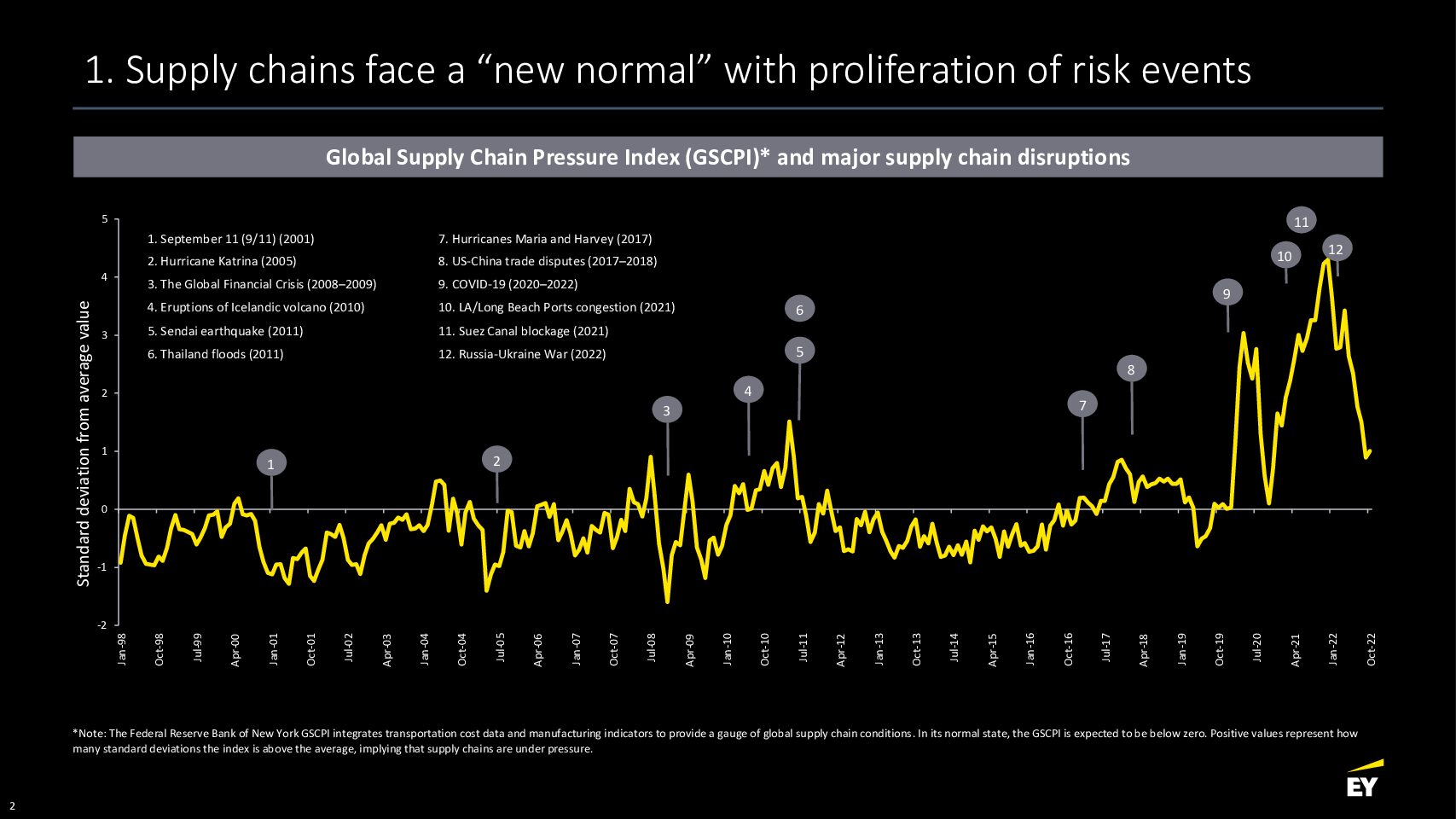Connected Business Ecosystems Can Boost Supply Chain Resiliency

In a time of unending disruption, the old model of linear supply chains optimized for cost efficiency must be rethought for resiliency and agility.

TAKEAWAYS:
● In a networked ecosystem, rivals can end up being partners in their supply chains, a development that was potentially unthinkable years ago.
● The levels of supply chain disruption repeatedly surged to record levels since 2020, highlighting the need for new strategies.
● Effective networked ecosystems are underpinned by reimagined architectures, greater end-to-end visibility, and technologies that enable faster decision-making and agility.
In the past decade, supply chains went from a back-office concern to front-page news, from enablers of strategies optimized for cost efficiency to potential sources of disruption that demand resiliency. Many organizations are slowly realizing that their supply chains are structured around market dynamics and operating models that are no longer relevant, and the solution requires efforts oriented outward — in networked ecosystems of supply — and not just inward.
To determine the way forward, it helps to reflect on what happened that took us to this point. The COVID-19 pandemic was a rupture with clear before and after points in our lives, yet it is only one part of a broader narrative that’s still unfolding: evolving technology enablers, geopolitical risks, and sector convergence are also complicating a landscape in which hardened borders and conflicts between governments are undermining globalization.
Against this backdrop, yesterday’s supply chain operations are ill-suited for today’s world — and grow more obsolescent in a business landscape that never returns to normal. When you pinpoint the forces affecting your organization, you clarify how best to build your roadmap to the future, and the partners to involve along the way.
Why Back to Normal Never Arrives
The past few years have felt like an endurance test of unprecedented chaos. Through its Global Supply Chain Pressure Index, the Federal Reserve Bank of New York backs up those feelings with hard evidence: since 1997, the beginning of the index, the levels of disruption repeatedly surged to record levels since 2020. The one-two punch of Japan’s Sendai earthquake and tsunami and Thailand’s catastrophic monsoon flooding in 2011 marked the high point of supply chain concerns before the COVID, but reflected just about a third of the standard deviation from the norm than what companies expected in 2021 and 2022.
This chart also illustrates how, until fairly recently, the major substantive supply chain disruptions were almost exclusively natural disasters, events that, while serious, but do not reflect persistent foundational challenges to business as usual. It’s feasible to recover from a natural disaster and return to normal in, say, three months. But a number of foundational challenges have made supply chains leaders feel like they’re always recovering, with normal further away than ever.
Around 2017, many companies experienced new headaches stemming from geopolitics, as the US and China, a key point in supply chains for many big multinationals, became embroiled in trade disputes. Today, the world is still grappling with the fallout of Russia’s war with Ukraine, which scrambled the markets for energy, certain precious metals, agriculture, and more. These events are representative of how the promise of globalization, forged after the collapse of the Soviet Union, has taken a turn into greater nationalism and populism.
More leaders globally have made tighter restrictions on the movement of goods and people across borders a defining principle of how they govern. Many trade blocs and agreements have been rewritten or discarded entirely, such as when then-President Donald Trump took the US out of the Trans-Pacific Partnership. Power blocs oriented around China, or more involving neutral nations like India and Brazil, have formed under “Globalization 2.0,” and as a result, many multinationals are left with supply chains that reflect a prior era of cooperation, exposing them to risk in today’s era of fragmentation.

“AI and data analytics can drive resiliency by identifying patterns in changing customer demands.”
At the same time, many governments have been implementing new regimens around tax rates, permanent establishment, and nonfinancial reporting that are challenging the equation for where companies do business. And technologies such as AI, Internet of Things connectivity, and digital twins have rewritten how companies compete and what they can achieve. In this environment, traditional sector boundaries are being blurred, and new business models are driving greater mergers and acquisitions for vertical integration or market/portfolio expansion, as well as regional strategies.
All these factors converge on supply chains — where they’re located, how they operate, and what implications and risks they have for the broader business. Linear supply chains with single sources, optimized for cost-efficiency and scale, must be rethought for resiliency and agility — as part of a networked ecosystem.
Building an Ecosystem
Amid so much disruption, rivals can end up being partners. Products in various stages of completion do not necessarily move in a straight line any longer; most companies rely on networks that might include hundreds or thousands of suppliers to create overly complex products such as consumer electronics or automobiles. For example, in the auto sector, one consumer electronics player will rely on another for the battery in the electric vehicle it is designing, even as they both fight for market share against each other in TVs.
This is an example of what we call a networked ecosystem, which enables the flexibility that multinationals need to thrive in today’s environment. Here are some tactics for managing and gaining oversight across your ecosystem — and making it pay off.
1. Redesign your strategic architecture and secure alternate sources of supply
Moving from a linear operating model to one that is agile requires a hard look at your global trade flows, global tax models, and network footprint. Beyond examining whether you have warehouses and manufacturing sites in the appropriate locations, scrutinize whether you have alternate sources of supply established, without heavy concentration from one vendor or geography. Single sources of supply are the symptoms of failures in today’s disruptive age, and by adding more redundancy to reduce bottlenecks and risk, you’re expanding your ecosystem. Also, pinpoint when to rely on third parties instead of enhancing in-house capabilities, and when to localize and/or diversify. Consider future-back planning: determine what results you want, then work from there to determine the foundational priorities and partners to enable them.
2. Embed end-to-end visibility within your ecosystem
An expanded ecosystem brings more variance in what you can achieve and optimize. Therefore, tools and connections that enable visibility are imperative. But too many supply chains run on disconnected systems, manual processes, and unstructured data. Suppliers and other players across manufacturing, logistics, and distribution typically have their own IT systems that may be connected within their own four walls, but not across the full supply chain, greatly reducing its impact. But in a true networked ecosystem, all the data can be stored in the cloud, and all entities can see and respond to events at the same time, instead of linearly. You have the opportunity to evaluate and develop multi-tier supplier visibility and to enhance inventory accuracy and visibility across all nodes.

“Using a digital twin to create a replicate of a supply chain can help in identifying contingencies. ”
3. Use data to enable supply and demand sensing and risk monitoring
This level of connectedness can drive companies move toward predictive, prescriptive, and autonomous decision-making, away from the reactive approaches that are ineffective or unsustainable. A bigger network benefits from optimal tools to drive performance; for instance, AI and data analytics can be used to identify patterns in changing customer demands, market conditions, and risks, driving increased resiliency and flexibility. This information can help you rapidly adjust production and implement predeveloped plans, such as acquiring more components from other suppliers in your networked ecosystem if a disruption surfaces.
4. Enable simulations to create contingencies
This data can also underpin a digital twin, a virtual replica of your supply chain used in simulations. What’s the impact of a loss of one supplier, or a new protectionist policy from a government, or a natural disaster in a key logistics hub, or another blockage in the Suez Canal? All these possibilities — whether a potential failure or source of optimization — can be tested in a digital twin to explore contingencies and hone strategies for events with a cascading impact across functions. By wargaming out scenarios, companies can capture advantages that their more sluggish rivals cannot. For example, Ukraine has positioned itself as a major supplier of car parts to Europe, including wire harnesses, a crucial foundational component in the assembly of vehicles. Russia is also a crucial provider of titanium for the aerospace and defense industry. Capabilities such as a digital twin would prove invaluable as war between the two nations went from rumor to reality.
The bad news is that disruptions are likely to continue to intensify and become more prevalent. But the good news is that the world is making strides to build more useful redundancy in supply, and enabling technologies are advancing and becoming easier to implement. Seen through the right lens, today’s challenges can be tomorrow’s opportunities, and normal isn’t worth pining for.
The opinions expressed in this article are those of the authors and do not necessarily reflect those of the EY global organization or its member firms. M
About the authors:

Aaron Pernat is a Managing Director at EY with experience leading large, multi-national supply chain organizations along with proven success driving business performance improvement.

Sven Dharmani is a Partner/Principal in Supply Chain & Operations at EY with a proven track record of driving process improvement, business transformation and turnaround in the automotive industry.
The Case for Investing in Supply Chain Visibility
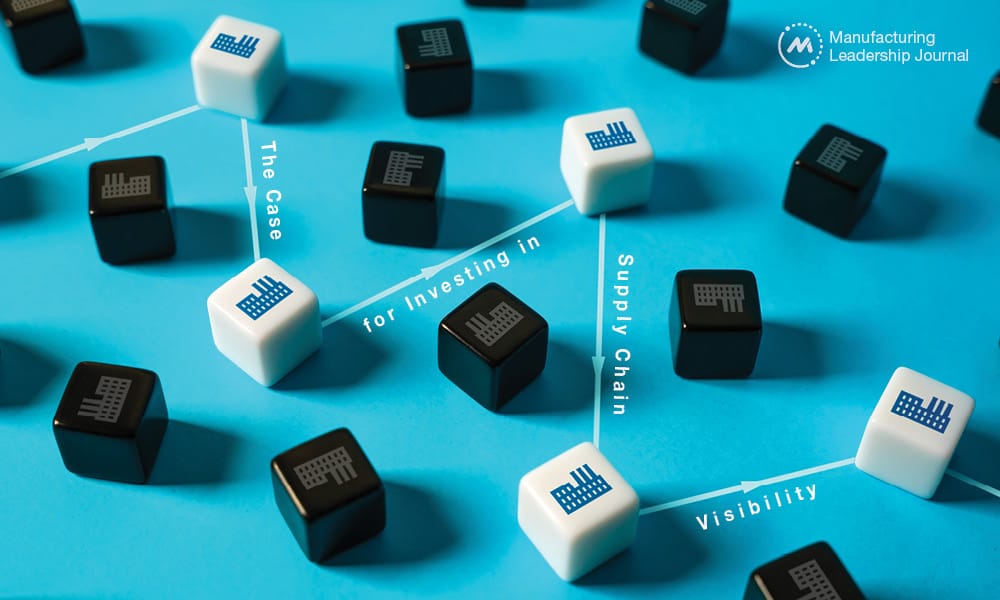
Three real-world scenarios illustrate where supply chain disruption can be turned into business opportunity.

TAKEAWAYS:
● Supply chain performance will remain essential to business success and resilience.
● Improving visibility beyond Tier 1 is necessary to avoid disruption, strategize on cost and quality, and comply with regulations.
● Close relationships with suppliers and other stakeholders can help manufacturers with supplier due diligence, onboarding management, and performance monitoring.
The White House’s June 2023 report indicating that supply chain disruption has eased is good news for manufacturers, but they should not let up on their investments in supply chain anytime soon. Disruption is not an “if”, but a “when”, and manufacturers who deprioritize supply chain today will be less prepared to adapt to future disruptions. Supply chain performance also remains a key differentiator in business success as a critical enabler of customer service excellence, cost efficiencies and resilience.
To hone a competitive edge in today’s operating environment, manufacturers must take several steps to adapt their supply chain strategies, including:
- Evolve from reacting to disruption to establishing the supply chain as a key driver of business value.
- Establish deep partnerships with key suppliers, as they are an integral part of maintaining quality, predictability, and on-time performance and optimizing cost.
- Develop an intimate understanding of extended supply chains beyond Tier 1 suppliers and work with all stakeholders to design a sustainable and resilient supply chain operation that drives competitive advantage.
Improving supply chain visibility is a key component of achieving these strategic goals. According to the 2023 BDO Manufacturing CFO Outlook Survey, 42% of manufacturers will improve supply chain visibility this year — but many are still not prioritizing this core element. Visibility means having sight beyond Tier 1 suppliers and downstream into customers’ operations.
Improving visibility is key for navigating disruption, adapting to new stakeholder expectations, modeling strategy and operational changes affecting cost and quality, and complying with regulations. It’s enabled by technologies like blockchain, sensors, ERP, and mapping and tracing technology and processes. Ultimately, investing in supply chain visibility will help transform this critical function into a driver of value and resilience for the entire business.

“Ultimately, investing in supply chain visibility will help transform this critical function into a driver of value and resilience for the entire business.”
But what do these principles look like in action? How can companies apply visibility to real-life situations? We’ve outlined three hypothetical scenarios and accompanying solutions to demonstrate how enhancing visibility can help turn disruption into opportunity across manufacturing subsectors.
Scenario 1: Outbreak in a Food Manufacturer’s Facilities
A food manufacturer operating in the dairy sector detected contamination in one of its facilities. Although the company was able to identify the ingredient responsible for the contamination, they lacked visibility into which facilities used the same ingredient from the same supplier. Consequently, they needed to shut down operations in any region where the potentially affected ingredient could have been used. The crisis resulted in significant revenue losses and damage to the company’s reputation.
Solution: Improve Visibility to Help Bolster Quality Control
To mitigate the impact of future contaminations, the company should consider digitizing all its supply chain data in a platform that can serve as a single source of truth. The platform could then be integrated with other applications such as ERP, MRP, P2P, and WMS. As a result, the company would be able to obtain a real-time view into all aspects of the supply chain and track which ingredients are used in each of their production facilities. By achieving this visibility, the business could quickly identify and isolate any future outbreaks without needing to unnecessarily shut down unaffected facilities. Real-time visibility would enable the company to respond more swiftly to mitigate these incidents, prevent wider disruption, and preserve revenue and its reputation.
The business should also collaborate with its suppliers to establish stronger quality-control procedures. This could include implementing defined quality assurance checkpoints throughout the supply chain to ensure quality without redundancy. This food manufacturer should also consider implementing lot tracking across different functional areas of the supply chain, from the supplier to final customer delivery, to improve traceability. Finally, the company should develop a standard and random audit program to confirm compliance with the new processes and verify the accuracy of data collected throughout the supply chain. Monitoring will help the company proactively identify lapses in the system before there is a real issue that escalates and causes harm.

“A standard and random audit program can help confirm compliance with new processes and verify the accuracy of data collected throughout the supply chain.”
As part of the rollout for these new procedures, the company should develop a comprehensive communication plan to inform the general public and customers about its supply chain quality control and visibility improvements. To rebuild trust, the communication plan should emphasize the company’s commitment to quality control, safety, and transparency. The plan should also include communications protocols for any potential future outbreaks.
Lastly, in addition to overcoming the outbreak issue, the business could use the supply chain data to improve performance. For example, the company could analyze the data to identify places to streamline the company’s manufacturing, logistics, and distribution networks, as well as opportunities to eliminate redundancy and rethink the network footprint to improve resilience.
Scenario 2: Transport System Failure for Medicine
A manufacturer specializing in the production and transport of insulin realized its temperature control system had failed when, upon delivery to a customer, it discovered that the insulin was exposed to high temperatures — and as a result, the entire shipment needed to be destroyed. The manufacturer could not pinpoint where the failure occurred during transport, nor the cause, which hampered the company’s ability to resolve the issue.
Solution: Implement Real-Time Monitoring to Protect Medicine
To mitigate this problem, the company should consider investing in sensors that monitor the temperature of shipments in real-time and transmit that data back to a central location. This will allow the company to pinpoint where and why temperature fluctuations occur and make changes to rectify the issue. It will also allow the company to easily determine which specific batches have been affected, so that a temperature fluctuation does not necessarily require discarding an entire shipment.
Sensors also add another layer of security by detecting whether the product has been tampered with — for example, during an unscheduled stop — and needs to be destroyed.

“To meet customers’ evolving expectations, manufacturers should prioritize building the digital thread to facilitate seamless communication up and down the value chain.”
As the federal government has designated pharmaceutical supply chains as a priority for onshoring to the U.S., pharmaceutical manufacturers will likely see new requirements to safeguard their products. Companies will need to meet these requirements to qualify for onshoring incentives and avoid scrutiny or penalties for imported products. Temperature sensors are one example of measures that pharmaceutical companies can take to improve supply chain visibility to comply with these potential new requirements. Companies may also be required to provide additional visibility into their financing and arrangements with foreign suppliers as part of the effort to preserve security.
Scenario 3: Adapting to Shifting Retail Business Models
An apparel manufacturer is struggling to adapt to shifting business models in the retail industry as more of its clients embrace a direct-to-consumer (D2C) model and experiment with hyper-customization of products. These changes have significant ripple effects throughout the supply chain, including requiring more agile ordering processes and the ability to quickly transfer information.
The manufacturer can’t keep up with the new level of agility its customers demand and is worried about losing sales.
Solution: Build the Digital Thread
To meet its customers’ evolving expectations, this manufacturer should prioritize building the digital thread: a communication framework that facilitates seamless communication up and down the value chain.
A true digital thread requires the sharing of information across the entire value chain, including from customers and suppliers. Technologies like ERP, data analytics, blockchain, machine learning, and others that facilitate the collection, analysis, and transfer of data make this level of information-sharing possible. The integration of advanced analytics into planning can help inform production planning, and the use of digital twin technology would enable the business to stress-test supply chain changes before implementation to minimize service disruptions.
Additionally, the apparel manufacturer should work with its retail customers to design new demand planning models to account for hyper-customization and establish plans to pivot as customer behaviors continue to evolve, rather than relying on historical trends. Building the digital thread will enable this manufacturer and its customers to respond quickly to changes in demand and be agile enough to shift business models and supply chain strategies to serve evolving needs.

“Manufacturers must balance the challenge of overcoming immediate disruption with the need to drive long-term competitive advantage by investing in supply chain visibility, tracing, and ongoing management.”
In addition, new labor regulations, import tariffs, quotas on certain materials, Customs & Trade Partnership Against Terrorism (CTPAT) participation, and environmental protection measures make it imperative for the manufacturer and its customers to increase visibility and control of the supply chain to maintain compliance and avoid disruption.
The Future of Supply Chain Collaboration
Manufacturers across sectors must balance the challenge of overcoming immediate disruption with the need to drive long-term competitive advantage by investing in supply chain visibility, tracing, and ongoing management. The most successful manufacturers will maintain close relationships with their suppliers and other supply chain stakeholders and will also establish robust processes that support supplier due diligence, onboarding management, and performance monitoring.
Although conditions continue to improve, their investments in visibility will pay off by enabling companies to proactively correct issues and mitigate weaknesses before a major disruptive event occurs. Additionally, greater supply chain visibility can support enhanced decision-making by helping manufacturers spot emerging trends and adapt accordingly to capture opportunities. Businesses that take these steps today can enhance resilience, drive competitive advantage, improve customer confidence, and preserve their reputation. M
About the authors:

Andrea Greco is Managing Director, Global Value Chain, BDO USA, P.A.

John Krupar is Principal, Global Value Chain at BDO USA, P.A.

R.J. Romano is Managing Director, Global Value Chain at BDO USA, P.A.
Moving Past the Crisis Mode
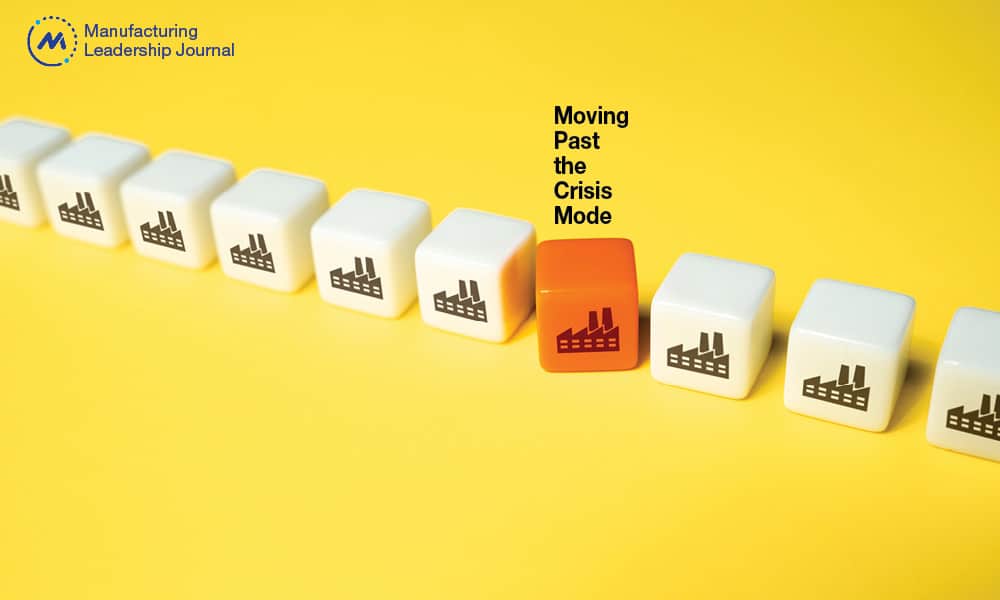
With supply chains moving toward more normalcy, it’s time to refocus on supplier risk management.

TAKEAWAYS:
● Supplier risk management programs were often neglected or circumvented in the face of recent supply chain challenges.
● As normalcy returns, shoring up these processes requires a holistic internal and external approach.
● Advanced technologies like AI are essential to developing a robust SRM program.
In the NAM Manufacturers’ Second Quarter Outlook Survey (June 2023), workforce challenges continued to dominate and concerns about a weaker domestic economy grew. But responses also hinted at better news on the supply chain front — 45% of executives surveyed cited the supply chain as a primary challenge. That’s a significant percentage but also down from 56% the previous quarter. More than 25% of manufacturers believe supply chain disruptions have already abated or will in the current quarter, and 53% of manufacturers expect improvement by the end of 2023.
While there’s still plenty of uncertainty, this sentiment suggests movement in the direction of “normalcy.” As that happens, we believe that it’s critical to revisit and reinvigorate supplier risk management (SRM) programs.
Given the extraordinary events of the past several years, it’s understandable that many manufacturers eased up on supplier risk management to ensure they could get what they needed to meet demand. Discipline waned on the buy side of the supply chain, with buyers often relaxing their practices for holding suppliers accountable to contract terms and enforcing penalties for non-compliance.
The pendulum is swinging the other way as supply conditions stabilize. Many manufacturers are beginning to again tighten and strengthen their SRM processes. Listed below are some considerations to accomplish that.
Six Considerations for Strengthening Your SRM Program
While technology is a key enabler of supplier risk management today, effectiveness depends on having a more well-rounded approach. Without that, you will struggle to realize value from the effort.
1. Start within your own house: There are multiple functions and parties involved in getting materials from suppliers into your plant. To be effective and ensure consistent application across functions, an SRM program must have multidisciplinary input and consensus. Having your own internal operations in order is essential before you can begin engaging suppliers in initiatives to improve visibility or collaboration.
2. Segment the supplier base: One of the most important principles of SRM is the application of segmentation to suppliers and supply markets; not all provide the same value to the organization or pose the same level of risk. Effective segmentation enables manufacturers to focus their efforts on strategic suppliers at the top of the pyramid that may provide enormous potential for partnership and collaboration. Expanding interfaces with certain strategic suppliers enables collaborative planning and forecasting, and it also improves both organizations’ efficiency.
But the potential is even greater. Collaborative R&D and innovation and joint market development initiatives can be a “force multiplier” for both parties. What’s more, the benefits of expanding strategic perspective further up and down the value chain can provide strategic risk management advantages, including earlier identification of both downside risks and upside opportunities.
3. Assess risk regularly, using a proven framework: Many organizations significantly expanded their supplier base during the pandemic to manage disruptions. This resulted in many short-term partnerships and non-optimal agreements. With a return to normal, a good SRM practice is evaluating the strategy behind each relationship, including updating service level agreements, pricing/service benchmarks, and volume commitments — not as a one-time initiative but on a regular ongoing basis.

“Having your own internal operations in order is essential before you can begin engaging suppliers in initiatives to improve visibility or collaboration.”
Organizations with new or less advanced SRM initiatives should consider starting with an enterprise-wide assessment that creates a holistic view of the supply chain risk profile to prioritize risks across the enterprise. This, then, provides the foundation for building an SRM program focused on areas of greatest risk. On the other hand, organizations with established SRM programs or with insight into known risks may take a “risk-based” approach, focusing diligence in those areas. This more in-depth analysis allows for deeper understanding of specific supply chain risks that may extend to other parts of the business with a similar profile. But because of its narrower focus, it may miss unknown risks or SRM best practices that already exist in the organization.
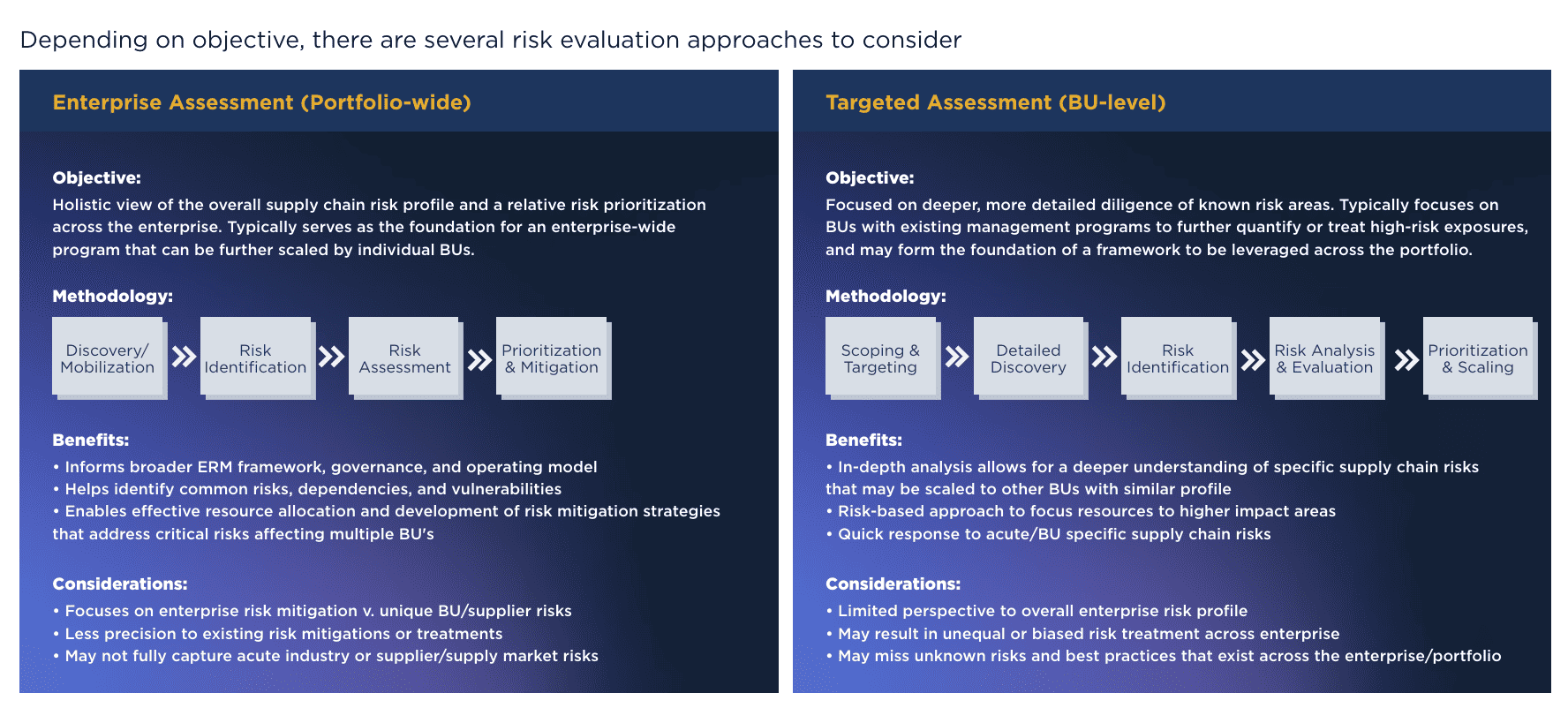
4. Elevate master data management: Quality and availability of data is the lifeblood of supplier risk management and the enhanced collaboration, efficiency, and performance it promises. Manufacturers that “digitize to the core” not only have the potential to become much more efficient and dynamic within but also gain the opportunity to expand competitive advantage at the “edge” by integrating with digitally enabled suppliers, vendors, and third parties. The ability to jointly transact, communicate, innovate, and create digital twin models aids in managing supply risk.
Capitalizing on this requires sound management of the data that may be highly sensitive or proprietary:
- Operational/Master data: products, parts, specifications, bills of materials, capacities, etc.
- Transactional data: orders, forecasts, lead times, payments, invoices, shipments, sales/point-of-sale, inventory, etc.
- Performance data: service levels, quality, Net Promoter® scores, etc.
Elevating master data management is next to impossible without moving away from Microsoft Excel and paper-based processes. This is where many manufacturing operations struggle. In our research with Supply Chain Dive, nearly 75% of manufacturing and distribution executives said they primarily use Excel in their sales and operations planning processes. This is not just slower and more laborious, it’s also more prone to errors and risks.
5. Mature data acumen and governance, wherever it resides in the company: In a digitally enhanced organization, people must be agile and capable of operating at two speeds: running the business while continuously exploring ways to use data to find, evaluate, and pursue new opportunities. This requires the ability to understand new risks from data sharing and systems integration, and to apply risk-based approaches to evaluating what is shared, protocols for sharing, and lines of defense to protect and remediate when needed.
Employees can no longer operate solely within their own functional siloes. They must have a baseline understanding of the data governance frameworks, protocols, and underlying data risks as they increasingly engage with digital interfaces within supplier ecosystems. This will require new skills, as well as education and change management across the functions that play roles in managing supplier risk.
6. Take advantage of evolving technology: Good visibility is key to managing supply risk. Visibility is the product of being digital. Leading manufacturers are trending toward more technology-enabled planning processes. This allows them to forecast more accurately and look further into the future. In addition to having better insight, digital organizations can do more with the same number of people.
Software companies are utilizing advanced technologies to transform supply chain risk management. They offer platforms that provide in-depth supplier risk assessments — which are customizable and dynamic — covering a wide range of risk categories. These assessments focus on various aspects, including location, company, and material risks, and are designed to build long-term resiliency by reducing the frequency and impact of events that can affect supply chains.
Artificial intelligence is revolutionizing supplier risk management by leveraging predictive analytics to foresee potential supply chain disruptions, considering myriad data points including geopolitical events, weather patterns, and suppliers’ financial health. It facilitates real-time monitoring of supply chain processes, tracking goods in transit, and monitoring supplier performance to detect and alert about anomalies before they escalate into significant issues.

“Expanding interfaces with strategic suppliers enables collaborative planning and forecasting, and it also improves both organizations’ efficiency. ”
AI also enhances supplier evaluation, sifting through data on performance, financial stability, and regulatory compliance to identify high-risk suppliers. By classifying suppliers based on their risk levels, AI aids organizations in prioritizing their risk management efforts towards suppliers who pose the most significant threat. AI also supports scenario planning by creating predictive models and running what-if scenarios, enabling organizations to understand the potential impact of different risks and plan their responses accordingly.
Some software solutions employ natural-language AI models trained on supply-chain data to modernize assessment and monitoring processes. These models help to anticipate and manage disruptions in supply chains more effectively. There are also AI-powered analytics engines that integrate data from numerous sources to predict supply chain disruptions or delays. From the inception of a purchase order, these engines provide predictive risk scores to inform buyers about potential supplier delays and their reasons.
Software solutions also exist that focus on risk due diligence in the source-to-pay process, aiming to mitigate disruption while safeguarding revenue and reputation. These tools are designed to automate all aspects of supplier performance and information management, scanning millions of online sources and providing risk alerts. Some solutions also offer comprehensive 360-degree supplier performance and risk management capabilities. Finally, there are software solutions that use AI to help organizations identify, analyze, and mitigate all types of supply chain risks. These comprehensive solutions streamline and automate the often complex and multifaceted process of supply chain risk management.
Key considerations for evaluating the use of new technology include:
- Data quality and availability
- Integration with existing systems
- Regulatory compliance
- Vendor capabilities and support
- Cost and return on investment
- Training and change management required
- Security
- Scalability to meet needs across the business
Taking Action
The right steps to take will, of course, depend on your operations and supply chain, and the maturity of existing SRM practices. Generally speaking, organization size and scale may be one guide for determining where to focus.
Because data is a critical foundation for supplier risk management, not to mention supply chain performance, building the fundamentals for becoming data-driven should be a top priority, particularly for smaller to mid-sized organizations that are early in the process of formalizing an SRM approach.

“By classifying suppliers based on their risk levels, AI aids organizations in prioritizing their risk management efforts towards suppliers who pose the most significant threat.”
Meanwhile, middle- to upper-middle-market manufacturers are typically at a size and scope of operations where a holistic view of the supply chain really starts to matter. In this category, SRM strategies are more common but tend to fall apart when an organization is missing one leg of the stool, whether it’s people and skills, data, technology, or processes. It’s important, then, to make sure the right foundation is in place. Additionally, organizations should look for opportunities to advance tried-and-true approaches, such as supply market segmentation or data sharing and collaboration with strategic suppliers. Pilot programs can be effective for testing and learning from new approaches.
Larger global organizations with established SRM strategies should make sure they are tightening the screws and driving supply-side operations excellence by reinvigorating programs that may have atrophied because of the conditions of the past few years. These organizations can also look for opportunities to modernize technology and begin taking advantage of the latest AI and other capabilities.
Wherever your organization falls on the spectrum, recognize that shoring up SRM practices takes effort, investment, and time to see impact. Simply put, it’s important to act now. While the supply chain may be moving toward more “normalcy,” instability continues to permeate the market. Having a firm handle on supply risk and managing it effectively is critical to future growth and competitive advantage. M
About the authors:

Sam Dawes is a Partner in the Consumer & Industrial Products practice at West Monroe

Brian Pacula is a Partner in the Operations Excellence practice at West Monroe

Alex Jay is a Senior Manager in the Consumer & Industrial Products practice at West Monroe

Brandon Cosey is a Senior Manager in the Operations Excellence practice at West Monroe

David McGraw is a Senior Manager in the Consumer & Industrial Products practice at West Monroe

Marcus Spranger is a Senior Manager in the Operations Excellence practice at West Monroe
Dialogue: Reflections on a Lifetime of Innovation

As the latest winner of the prestigious Lifetime Achievement Award at June’s Manufacturing Leadership Awards Gala, Dr. Don A. Kinard considers lessons from the industry’s past and what excites him about its future.

From achieving the rank of Eagle Scout in the Boy Scouts of America to leading design and production engineering teams on the F-22 and F-35 fighter aircraft, Lockheed Martin Senior Fellow Dr. Don A. Kinard has accomplished a lot over the years. But what he is perhaps most known for is his ability to describe complex technical concepts in a language that anyone can understand, and doing it with warmth, grace, and a touch of humor.
Dr. Kinard was the most recent recipient of the Lifetime Achievement Award, which is granted by the Manufacturing Leadership Council’s Board of Governors when a qualified candidate is nominated. Here he shares his insights on what he’s learned over the years and his future plans as his career at Lockheed Martin draws to a close.
Q: What is the best piece of advice you ever received in your career?
A: When I look back there are really two pieces of advice that I’ve found to be instrumental in my career. The first is from my dad, who told me that your personal integrity and honesty defined who you were and how others perceived you. Second is the Boy Scout Motto – “Be Prepared” – which means that you should always have a Plan B when Plan A doesn’t work in life and in your career. Manufacturing requires the ability to anticipate and be prepared, in advance, to deal with disruptions.
Q: If you were to tell a future manufacturing leader one thing that they need to know to find success, what would that be?
A: I tell my mentees and colleagues that the best thing they can do for success is to understand who your customers and suppliers are and “walk a mile in their shoes,” meaning that you need to understand what they do and how they do it and how they impact the manufacturing enterprise.
Q: Which of your career accomplishments has made you the proudest?
A: It’s a tough one as I’ve been fortunate to be in several impactful roles in my career first in composites and then with the F-22 Program in design and manufacturing. However, the proudest moment was standing out on the runway with my team and watching the first flight of the F-35 in Fort Worth, Texas, and thinking about the years of intense effort and dedication it took us to redesign the aircraft and modify the manufacturing approach, which has proven to be a such a great success as we achieve full rate production.
Q: You have seen revolutionary technological change within the industry, which also means that leadership skills have needed to change. What do you think are the most important skills and attributes for leaders to have in manufacturing’s digital era?
A: I think the greatest skill for manufacturing professionals is to understand how the extended enterprise (engineering, supply chain, sustainability, finance, HR, business development, etc.) functions and how these components of an enterprise are integrated and optimized for mutual benefit. Functional silos blind organizations to opportunities. It is also important to understand the technology required to produce your products and appreciate and enhance the talents and teamwork of your employees to create the best atmosphere for success. My motto as the Technical Advisory lead for Lockheed Martin manufacturing is, “Manufacturing brings engineering to life.”
Q: What do you foresee as manufacturing’s great challenges and opportunities in the years ahead?
A: For U.S. manufacturers I’m concerned about the offshoring of manufacturing and manufacturing technology to Asia, Europe, and low labor cost countries. This has created significant issues in our supply chains. For example – rare earth and battery materials as well as semiconductors. In addition, I fundamentally believe that you cannot design what you can’t manufacture, and that true innovation exists at the interface between engineering and manufacturing. Our future depends on developing industrial policies (like the CHIPS and Science Act) that recognize the importance of onshore manufacturing to the security of the United States and our allies, the prosperity of our people, and our nation’s economic strength.
Q: As you draw closer to retirement, what are your plans for life after Lockheed Martin?
A: I have always enjoyed teaching and mentoring. When I was a new employee at Lockheed Martin I volunteered for GED (high school equivalency) tutoring for several years and recognized the value of education to our society and the effort put forth by immigrants to this country to contribute and succeed. I believe that STEM education is critical and that understanding and appreciating math may be a defining enabler of individual success. Therefore, I look forward to opportunities to continue to share this STEM passion in my community as well as participate in several aerospace industry associations I’ve been active in for a long time. M

FACT FILE: Lockheed Martin
Headquarters: Bethesda, Maryland
Industry Sector: Global Security and Aerospace
Annual Revenue (2022): $66.15 billion
Employees: 115,000
Production: 370 manufacturing sites
EXECUTIVE PROFILE: Dr. Don A. Kinard
Title: Senior Fellow, Lockheed Martin Aeronautics Operations
Education: Trinity University (B.S.); Texas A&M University (Ph. D)
Previous Roles:
– Deputy, Joint Strike Fighter Production System
– Director, Joint Strike Fighter Production Engineering
– Engineering Lead and Deputy Director, F-22
– IPT Design Lead, F-22
About the author:
Penelope Brown is Senior Content Director of the NAM’s Manufacturing Leadership Council.
SURVEY: Choppy Supply Chain Seas Making Skilled Sailors
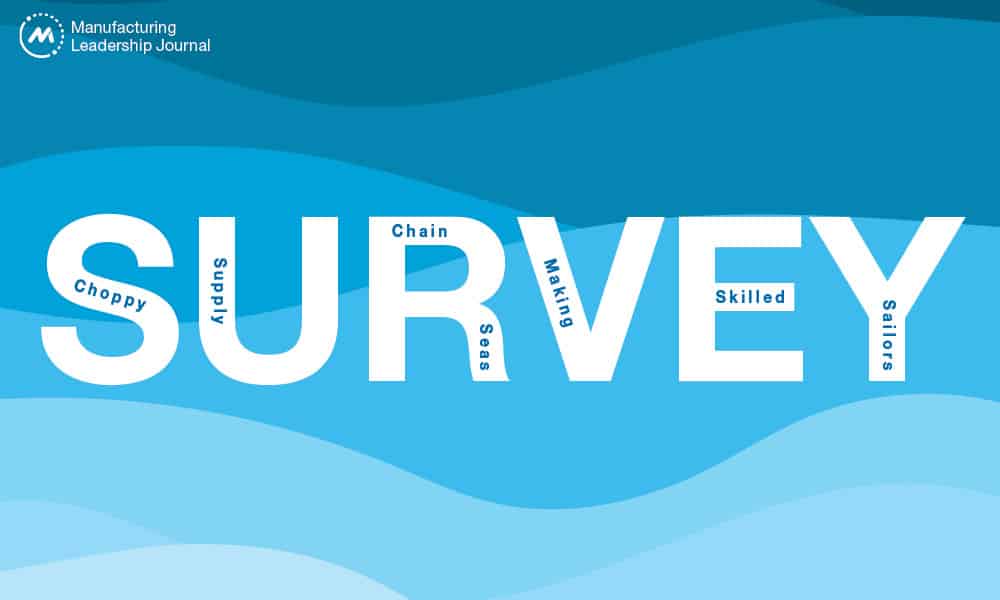
MLC’s latest survey reveals continued disruptions and challenges but big shifts in digital technology deployments and supply network geography.

Franklin D. Roosevelt is credited with saying, “A smooth sea never made a skilled sailor.”
As we move another year away from the COVID-19 pandemic that set off a wave of supply chain disruptions, we continue to see how those initial ripples have been amplified and compounded by component and material shortages, inflation and transportation cost increases, worker shortages, military conflict, political tensions, and other complexities that have tested supply chain resiliency.
In the face of these stormy seas, the manufacturing world continues to implement technologies and solutions to help overcome ongoing disruptions while girding supply chains for a more resilient future.
The MLC’s latest Resilient M4.0 Supply Chain survey reveals manufacturing leaders’ expectations and insights related to supply chain challenges, digital technologies, partnerships, and resiliency. It is clear that disruption still abounds, and respondents expect this to continue for at least the next 12-24 months.
At the same time, this year’s survey indicates that supply chains may be less resilient than our 2022 survey found. Nearly 23% of respondents now say their supply chain is not resilient – up from 12% last year. Perhaps, this sentiment is driven by the necessary rapid digital transformation and geographic shift that many supply networks have undergone.
If the supply chain waters remain choppy, manufacturers’ efforts to implement technology, transform their supply networks, and create better partner collaboration will lead to skilled sailors who can navigate future disruptions or calm seas – whenever those arrive.
Part 1: Supply Chain Disruptions
What started with a single cause for disruption is now a mixing bowl of many disruptive factors that continue to cause issues for manufacturers. Supply chain disruptions that were initially rooted in the COVID-19 pandemic have expanded to include the Ukrainian War, tensions with China, and more.
Still, survey respondents report that pandemic-induced disruptions have eased some. About half say they have eased significantly or partially while 47% say they have only eased minimally. [CHART 1] Meanwhile, other high-visibility supply chain disruptions from the Ukraine War and China tensions are not causing significant disruptions at this time, with nearly 67% of respondents reporting minimal or no disruptions from these catalysts. [CHART 2]
Despite the easing of disruptions from the pandemic and the reported low impact from Ukraine and China, respondents still see supply chain disruptions lingering for some time. In fact, nearly 36% believe disruptions will last for more than a year and nearly a quarter more believe the disruptions could stretch into 2025. [CHART 3]
Perhaps the lingering supply chain issues stem from several disruptive forces and a synergistic effect as several supply disruptions combine to become causes for further disruption. We asked about eight different types of disruptions that manufacturers have experienced in recent years and their impact. Leading the charge, component shortages and excessive cost rises for materials and shipping both ranked as a four or five (highest level of impact) for 17% of respondents, while demand drops, raw materials shortages and reduced productivity from labor shortages and equipment failures round out the top five disruptions with the highest impact. [CHART 4]
But from adversity, innovation arises, and manufactures report they are taking steps to mitigate future supply chain disruption. Among the leading new strategies, 55% say they are adopting supply chain analytics and digital technologies; 48% are increasing their focus on regional or local production and reshoring; 42% are focusing on regional and local supply chain partners; and 39% are improving their supply chain visibility and transparency. [CHART 5]
1. Pandemic-related Disruptions Persist
Q: To what extent have pandemic-induced supply chain disruptions eased for your company? (select one)

2. Global Unrest and Tension Causing Minimal Supply Chain Disruption
Q: To what extent have the Ukraine War and tensions with China affected your supply chain? (select one)

3. Most Expect Disruptions to Subside in Next 12-24 Months
Q: If you are still experiencing supply chain disruptions, when do you expect the disruptions to subside? (select one)

4. Components, Raw Materials, and Costs Causing Biggest Supply Chain Impact
Q: Over the last several years, what have been the most impactful types of supply chain disruptions you have encountered? (scale 1-5, where 5 is highest level of impact)
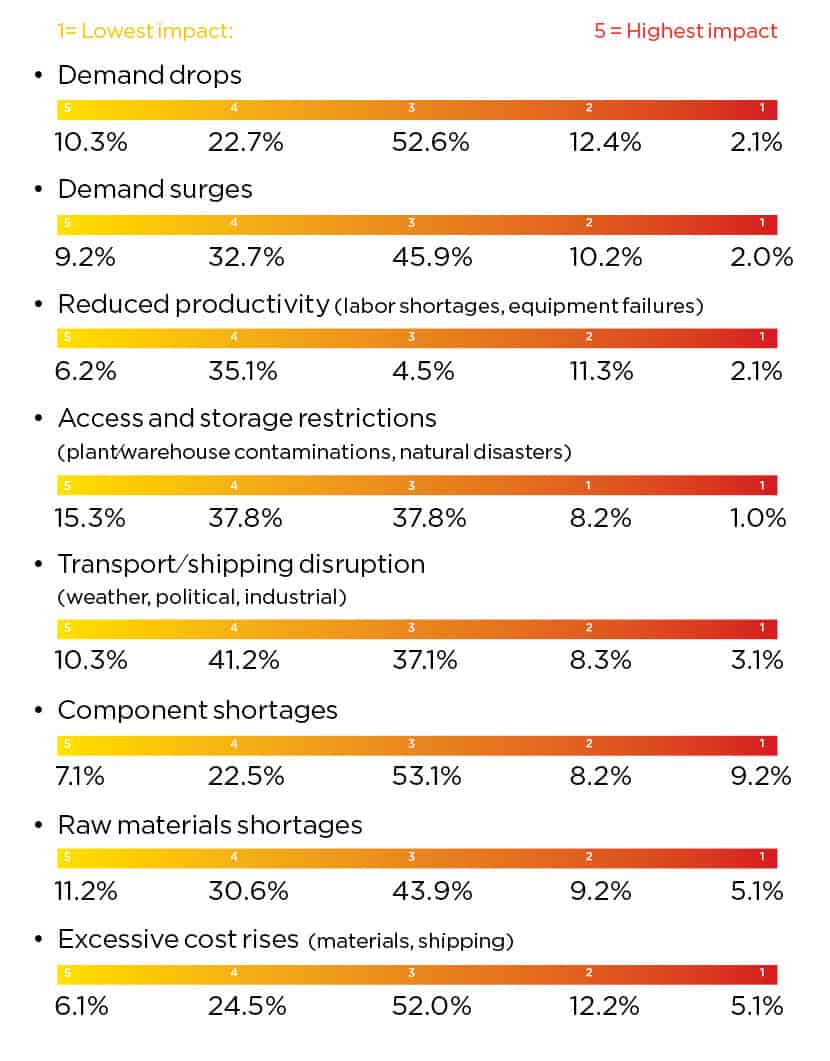
5. Analytics/Digital Tech and Supply Chain Geography are Biggest Strategies to Avoid Disruption
Q: What strategies are you adopting to mitigate future supply chain disruption? (select all that apply)

Part 2: Improving Resiliency
Building off these new strategies, manufacturers report a dramatic shift in their supply chain network’s geography. In MLC’s 2022 supply chain survey, 51% reported a global supply chain network. Now, just 18% of respondents report a global network. This shift has led to a significant increase in those with a national focus (43% in 2023 compared to 12% in 2022) and a combination of different approaches (30% in 2023 compared to 19% in 2022). [CHART 6]
The rapid nature of this shift may be responsible for a less resilient supply chain in the short-term. While most respondents still report their supply chain is somewhat resilient (71% in 2023 compared to 73% in 2022), there has been an increase in those reporting that their supply chain is not resilient. For 2023, that number stands at nearly 23% while it was 12% in April 2022. [CHART 7] Time will tell if this is, in fact, a temporary regression as supply networks realign geographically.
One way manufacturers may be bolstering their resiliency is reexamining traditional supply chain strategies. There is a clear move away from the Just-in-Time (JIT) approach. In 2022, 12% reported that they were continuing to use JIT, while just 3% continue to use it according to the latest survey data. Now, 65% of respondents report that they formerly used JIT, but have moved to a different approach. [CHART 8] Additionally, just under half of respondents (47%) report they are moving towards or have adopted an end-to-end value model other than SCOR. That leaves 2% that are using SCOR and nearly 37% that are adopting or have adopted the SCOR Digital Capabilities Model for Supply Networks. [CHART 9]
As these shifts take place, there is some optimism that the efforts will pay off in the next two years. Forty-one percent of respondents report that their supply chain functions are mostly siloed today, but that number is predicted to drop to just under 12% in 2025. At the same time, partially integrated supply chains are predicted to grow from 49% to 67% while those with a fully integrated supply chain are forecasted to increase from 6% to 18%. [CHART 10]
6. Companies Shift Away from Global Supply Chain Network
Q: Geographically, how is your supply chain network structured? (select one)

7. Still, resilient supply chains remain an issue
Q: How would you rate your current supply chain’s resiliency? (select one)

8. Just-in-Time’s Usage Continues to Fade
Q: How would you describe your company’s use of the Just-in-Time approach? (select one)

9. End-to-End Value Models Moving Toward Majority Adoption
Q: Does your company use SCOR as its basic supply chain model or are you using or moving toward a different end-to-end value model? (select one)
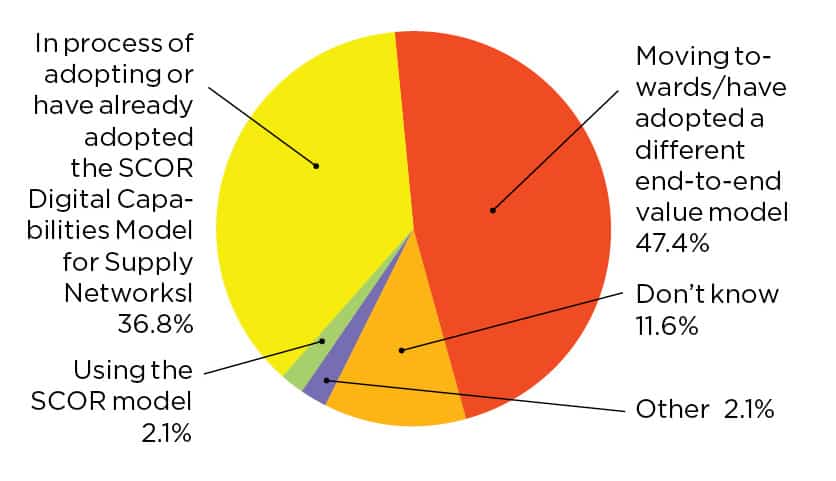
10. Siloed Supply Chain Functions Begin to Disappear
Q: To what extent are your supply chain functions integrated today and do you expect them to be integrated in two years’ time? (select one)

Part 3: Digital Supply Chains
For respondents, their digital maturity for external supply chain functions is slightly outpacing their internal supply chain functions’ digital maturity. Just under 90% say some, most or all their external functions are digitized, while 81% say some, most or all their internal functions are digitized. This means that about 18% of respondents characterize their internal supply chain functions as mostly in an analog or manual state, while about 11% of respondents say the same about their external functions. [CHART 11]
Many technologies are now in use to help digitize manufacturers’ supply chains. Currently leading the pack are cloud systems (in use for 42% of respondents) and augmented and virtual reality (32%). Rounding out the current top five, are artificial intelligence/machine learning, collaborative robotics, and Industrial Internet of Things (IIoT), all of which are being used to digitize just under 31% of respondents’ supply chains. Looking ahead to 2025, use of these technologies will most likely increase. Cloud systems are expected to be in use for 48% of respondents; IIoT is expected to be employed by 39% of respondents; cobot deployments will grow slightly and be in use in 33% of respondents’ supply chains; and AI/ML is expected to be in use for 38% of respondents. Our respondents also expect automated guided vehicle usage to grow from 30% now to 38% in 2025, while augmented and virtual reality usage will slip to 28% in two years’ time. [CHART 12]
As digital technology adoption grows, companies are no longer taking the opportunity to also redesign their supply chain processes. This may be because so many reported that they were redesigning their processes in the 2022 survey. At that time, 72% said they were redesigning their processes as they adopted more digital technologies. In the most recent survey, however, that number has dropped to just 26%. [CHART 13] If AI adoption grows as expected by 2025, it will be interesting to keep an eye on supply chain process redesigns to see if there is a corresponding increase.
11. Digital Maturation Continues
Q: Which description best characterizes the digital maturity of your internal and external supply chain functions today (plan, source, make, deliver)? (select one)

12. Cloud Systems, AI/ML and AGVs are the Present and Future of Digital Supply Chains
Q: What technologies are you currently using and do you expect to be using in two years to digitize your supply chain? (select all that apply)

13. Digital Adoption Not Driving Supply Chain Redesigns
Q: As you adopt more digital technologies across your supply chain, are you also taking the opportunity to redesign your supply chain processes? (select one)

Part 4: Supply Chain Partners
Perhaps driven by more localized supply networks, companies are making an effort to help their supply partners accelerate their digitization efforts. In 2023, 54% of respondents say they are helping their supply partners. This is up significantly from 2022 when just 19% reported they were supporting this effort. [CHART 14] Eventually, these efforts may ensure a more effective end-to-end digital supply network including multiple supplier tiers.
A potential area for growth with partner collaboration is data sharing. Just under 11% of respondents say they share data extensively with some partners while 5% say data is not routinely shared. But there is a light at the end of the tunnel: 38% say they are beginning to share supply chain data among partners and another 46% say they are partially sharing data across their networks already. [CHART 15]
14. More than Half Aid Supply Chain Partners’ Digital Maturity
Q: Has your company made any specific efforts to help support your supply chain partners accelerate the maturity of their digitization efforts to ensure a more effective end-to-end digital supply network? (select one)

15. Nearly All Respondents Share Some Data Between Supply Chain Partners
Q: To what extent is data routinely shared between any or all of your supply chain partners? (select one)

Part 5: Challenges, Goals and Outcomes
To implement an end-to-end digital supply chain strategy, significant challenges exist that must be addressed with organizational and people changes or new technologies. Respondents were asked to identify their top three challenges. Lack of common data platforms across the supply network led the way in the 2023 survey with 48% of respondents identifying this challenge. This is down slightly from 2022 when it appeared in 53% of respondents’ top three. Trailing just behind, 47% of respondents labeled the unwillingness of partners to share data as one of their biggest challenges. Beyond data hurdles, 42% say a lack of leadership buy-in and 36% say low digital maturity of supply chain partners are holding back their digital supply chain strategy. Meanwhile, 32% say that access to an adequate budget or investment is one of their top three challenges. [CHART 16]
Survey respondents are seeking several business goals related to their digital supply chain transformation. Increased supply chain resiliency, improved customer experience, and new business model/competitive advantage rank as the top three most important goals. These were identified as high importance on 43%, 33%, and 31% of the surveys, respectively. [CHART 17]
16. Data Issues Pose Biggest Challenge to End-to-End Digital Supply Chain Strategy
Q: What are your company’s primary challenges in implementing an end-to-end digital supply chain strategy? (select top three)

17. Customer Experience, Resilience Biggest Goals of Digital Supply Chain Transformation
Q: How important are the following business goals associated with your digital supply chain transformation? (rate as low, moderate or high importance)

About the author:

Jeff Puma is Content Director for the Manufacturing Leadership Council
Survey development was led by the MLC editorial team with input from the MLC’s Board of Governors.
Welcome New Members of the MLC August 2023
Introducing the latest new members to the Manufacturing Leadership Council


Mike Bommarito
Executive Director, Manufacturing Services
American Axle & Manufacturing

aam.com
![]()
https://www.linkedin.com/in/mike-bommarito-36b7277/

Paul Burke
SVP Global Operations
Teknor Apex Company

teknorapex.com
![]()
https://www.linkedin.com/in/paul-burke-71548116/
Erik Daron
President – USA
Teikoku Pumps USA
teikokupumps.com
![]()
https://www.linkedin.com/in/erik-daron-2561511/

Bruce Duncan
IT Director
McWane Ductile
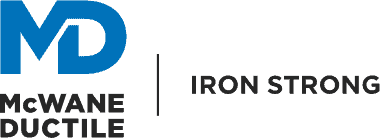
mcwaneductile.com
![]()
https://www.linkedin.com/in/bruce-duncan-967a697/

Kim Goodwin
Senior Director, Global Business Development – P&G Product Supply
PROCTER & GAMBLE

pg.com
![]()
https://www.linkedin.com/in/kim-goodwin-0ab1033/

Mario Guerendo
Chief Information Officer
Cummins

cummins.com
![]()
https://www.linkedin.com/in/mario-guerendo/

Coston Wheeler
Project Analyst/Manager
TARA Manufacturing
tarapools.com
Supply Chain Evolution: From Disruption to Resiliency
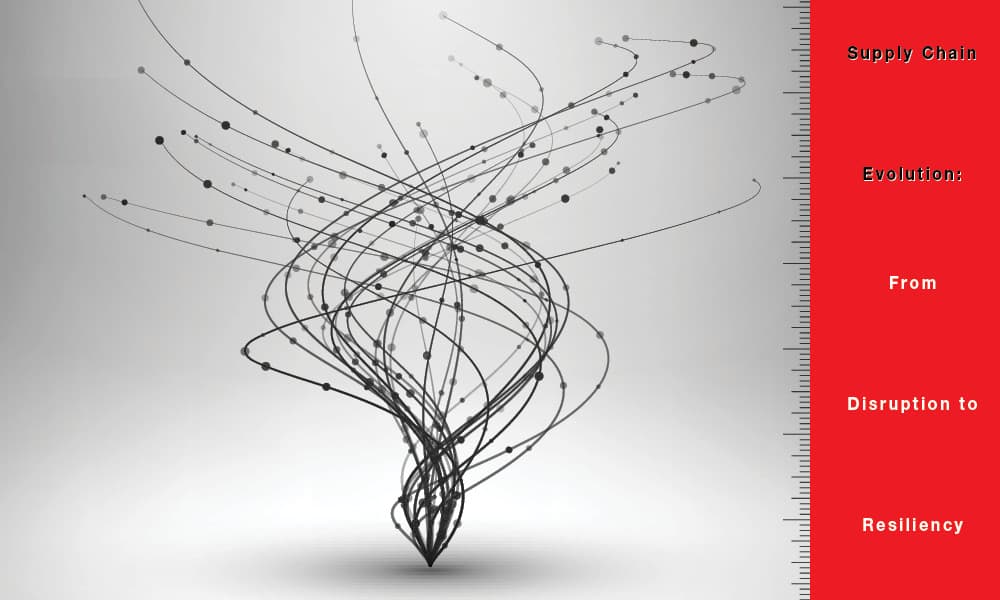
The need to integrate manufacturing and engineering into supply chain planning and the five evolution levels companies need to consider.

TAKEAWAYS:
● True supply chain innovation and transformation come from integrating all key stakeholders and requires a platform approach.
● Invest in people and processes to reach new levels of efficiency and leverage technology to help provide the structure and tools to enable them.
● It is a long journey. Define your end-vision and map out the evolution to achieve incremental benefits to help fund the transformation at each stage.
Introduction
Most companies now consider disruption to be a constant rather than an exception in business operations. This drives increasing challenges for companies in today’s ever-changing business environment. To overcome them, companies have a bewildering array of technologies available, but they should also integrate more stakeholders into the planning process to develop holistic and feasible strategies.
Companies will need to adapt and evolve in order to be resilient against future disruptions. However, adapting to this can be challenging, as there are many philosophies, solutions, and processes available to effect change. Initially, companies should understand some of the fundamentals needed to reach supply chain agility, visibility, and resiliency, and then ask what is needed to meet requirements such as stakeholder integration, defined workflows for managing supply chain risks, access to data, key technology capabilities, and a common operational framework.
Figure1: Fundamental building blocks for Supply Chain Resiliency
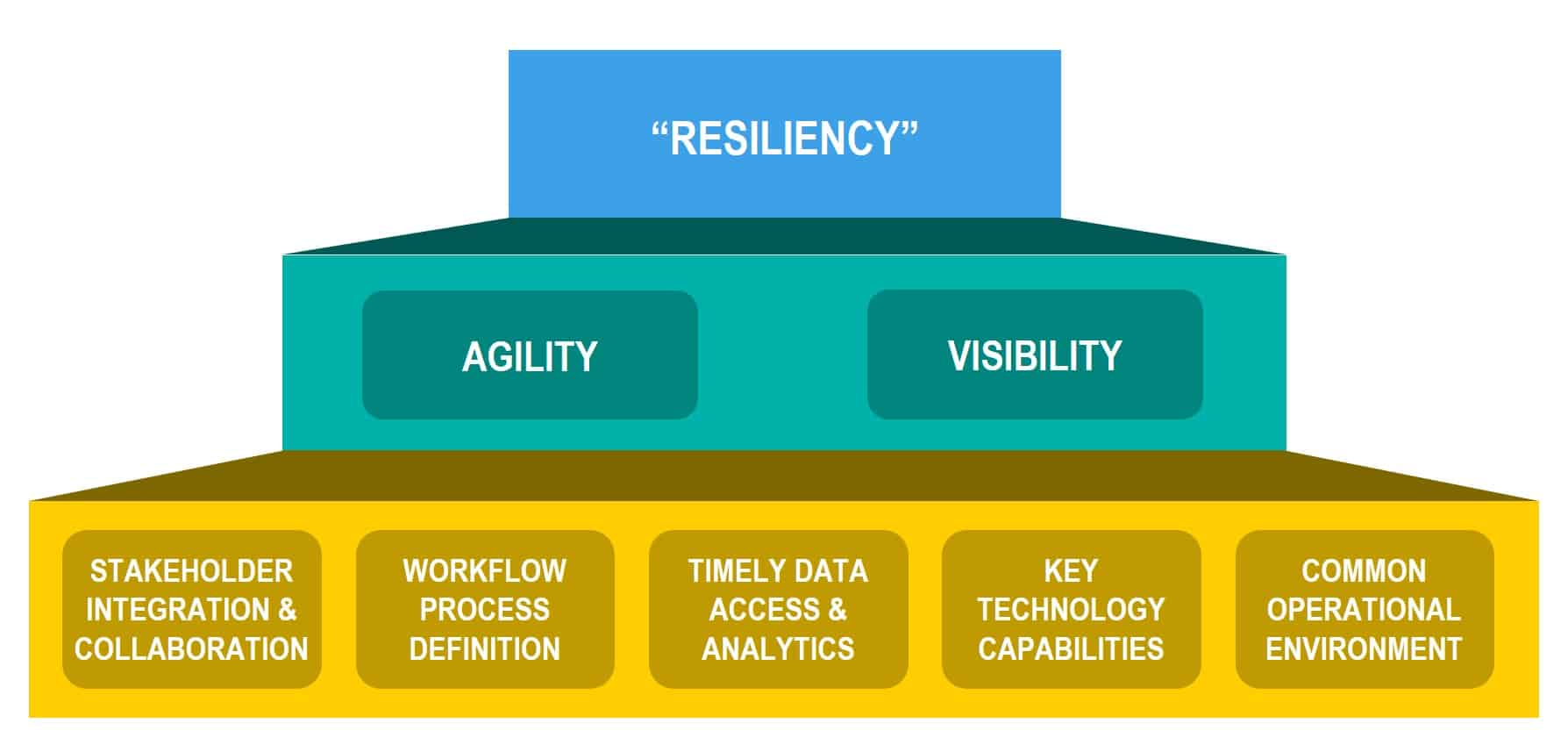
Five Stages of Supply Chain Evolution
Achieving supply chain resiliency is not a short-term endeavor. For most, it will be a journey of progressive evolution, capabilities and results. This evolution can be broken down into key milestone stages that help define important steps and how to focus on process and technology changes.
Figure:2 Key stages of supply chain evolution
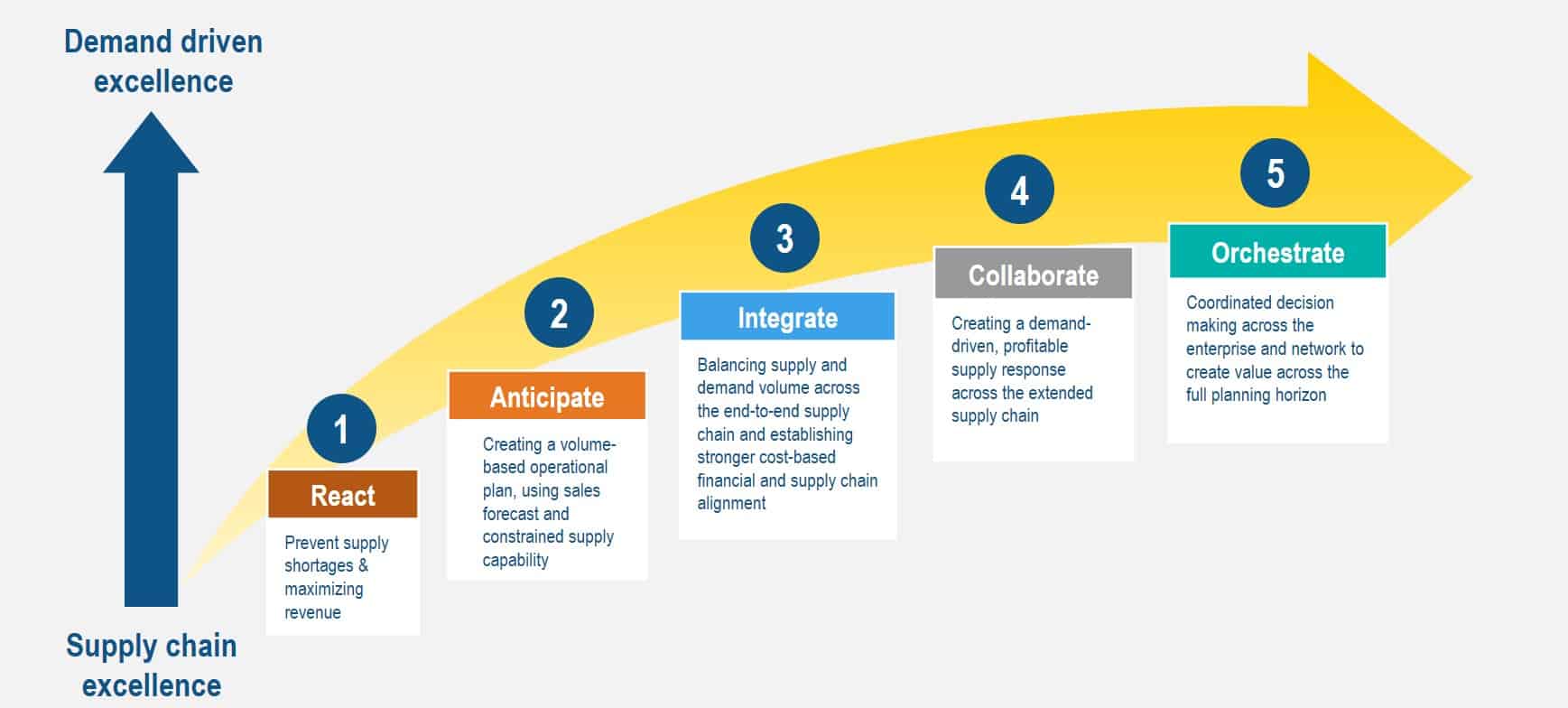
Early Stage Evolution (Stages 1-2)
Companies in the early stages probably still rely on manual processes, spreadsheets, or homegrown applications, and their focus is usually entirely on internal operations. The opportunities at this stage are to enable new levels of automation and more robust processes. This will help stakeholders manage the data and workflows needed to stop reacting and start making more proactive and collaborative decisions. There are also opportunities to introduce the first levels of optimization to help develop better forecasting and planning of operational models.
Mid-Stage Evolution (Stage 3: The Tipping Point)
The fundamental change in focus at the mid-stage is to stop thinking of the supply chain as an isolated and internal operation. Most supply chains are heavily dependent on additional stakeholders inside the organization.
- Operational divisions support the business model, so additional stakeholders need to be included in the decision-making process. Finance is an especially important role to include in the process as they represent the fundamental business metrics and goals for success.
- Supply chain planning is generally strategic in nature, but tactical execution can influence performance and long-term goals. For manufacturers, production operations can both present opportunities in developing strategic plans and disrupt plans already in place. Including manufacturing execution and scheduling as part of the planning process can help achieve strategic goals.
There are many challenges related to collaboration and the management of new types of data and information, but achieving this level of maturity means companies have developed a robust Sales & Operations Planning (S&OP) process and have started to enable the first elements of Integrated Business Planning (IBP).
Late Stage Evolution (Stages 4-5)
Previous stages enabled a maturity level of all internal processes and planning. However, since supply chain operations are often outsourced or dependent on third parties, it is important to consider external stakeholders as part of the collaborative process too. In addition, the growing scope and complexity of the planning process requires new levels of automation beyond just facilitating workflow and data management.
- External stakeholders: Whether it is alternative supply sources, contract manufacturers or logistics partners, it is impossible to make confident supply chain decisions without being able to model the details of the extended value network.
- Autonomous supply chains: It is likely that the workforce managing the supply chain process is becoming busier and/or more constrained. With the explosion of the volume of data and variables now being considered, optimization should now be applied to resolve supply and demand changes automatically wherever possible (e.g., within certain thresholds of acceptable outcomes). This way, supply chain professionals can manage “by exception” and spend their time on value-added activities.
In addition to including external stakeholders, supply chain organizations need to recognize the critical dependencies of other internal divisions on overall success. Some of the greatest opportunities (or risk mitigation) come from considering manufacturing and product design and engineering as critical stakeholders in the planning process.
Integrating Manufacturing & Engineering
Design, engineering and manufacturing processes have a significant impact on overall supply chain efficiency and effectiveness. For example, a design change can lead to better supply chain planning by reducing the number of components or materials, which can lower costs and improve delivery times. Similarly, changes in manufacturing plans can lead to better supply chain planning by increasing production efficiency and reducing inventory levels.

“Companies have a bewildering array of technologies available, but they should also integrate more stakeholders to develop holistic and feasible strategies”
In reverse, supply chain strategies can also affect engineering and production planning. A company may decide to outsource certain manufacturing processes to reduce costs and improve delivery times, which may in turn influence the product design.
Many supply chain problems have root causes in the disconnection between these important stakeholder divisions. Similarly, companies are missing innovation opportunities by not planning holistically across all enterprise stakeholders simultaneously. To achieve true supply chain resiliency, it is now imperative to develop a strategy that integrates manufacturing and engineering into the planning process.
Value Network Orchestration
Adding internal and external stakeholders and data to the process increases the complexity of developing consensus planning. Really, the process becomes more of a need to orchestrate all the numerous elements and possible scenarios to ensure alignment. Two critical technology solutions that can help this orchestration are digital twins and collaborative platforms.
Digital Twins
Already proven for product and facility process modeling, digital twins represent the ideal solution to enable companies to innovate and rapidly experiment with real world challenges without risk or excessive cost. Supply chain planning can benefit from the same philosophy. The supply chain digital twin models the extended value network and uses real-time data to update the status and allow planners to simulate unlimited what-if scenarios to plan for the future.
Additionally, since many companies have already invested in digital twins of their products and resources, connecting the digital twins enables the necessary integration between operations, engineering and manufacturing processes.
Collaborative Platforms
While connected digital twins allow the sharing of data and models, humans are still required to help orchestrate the process. This is where a collaborative platform becomes essential. Just as supply chain evolution moves companies from spreadsheets to automated S&OP, achieving true orchestration means stakeholders should collaborate and communicate as seamlessly as possible.
The collaborative platform provides a common structure for visualizing data, posing questions, publishing scenarios and making confident decisions. As each stakeholder and department may have separate goals and objectives, the key to success is to provide timely information and transparency as they collaborate cohesively on models of the enterprise and plans.
Industry Applications
Every organization has unique factors and challenges but achieving supply chain resilience requires evolution regardless of industry.
Discrete manufacturing industries such as automotive, aerospace, and industrial equipment have already invested in digital twin technologies from design and engineering to process simulation and digital manufacturing. It now becomes a natural extension for their operations teams to leverage the existing digital models during supply chain planning. This makes designing for supply chain a strategic advantage in new product innovation and enables extreme agility and visibility to supply chain challenges throughout the enterprise.

“To achieve true supply chain resiliency, it is now imperative to develop a strategy that integrates manufacturing and engineering into the planning process”
Process manufacturing industries such as consumer packaged goods, energy, and metals are also users of process simulation, but they are also increasingly investing in the digital modeling of their products. Instead of discrete parts, virtual models represent formulations, recipes and ingredient mixes. In the same manner, these industries can inform their supply chain decisions with a more holistic view of product potential and manufacturing dependencies.
Delivering Sustainable Supply Chains
More effective planning helps optimize supply chain and logistic flows to reduce emissions, energy consumption, and waste across the value network. Matching supply and demand with optimized S&OP also means a more efficient use of resources, raw materials and energy.
However, connecting the supply chain to engineering and production operations also provides unparalleled new opportunities to drive sustainability initiatives:
- Digital twin technology allows integration of product design with supply chain planning to design an efficient production system built for scalability and removing excess material waste.
- Efficient product design and engineering as well as considering reverse logistics and disassembly keeps valuable and scarce materials in the supply chain — enabling a circular production system.
- Connecting supply chain planning to downstream operations and consumer feedback allows for innovation in the design of green products, with opportunities to reduce the overall production footprint.
- Connecting a broad range of stakeholders enables more productive continuous improvement collaboration and ideation in areas of efficiency and sustainability.
Value
Each supply chain evolution can bring substantial value and benefits. Simple automation and optimization can greatly increase planner efficiency and accuracy. This efficiency continues to scale as maturity levels increase to include more stakeholders and capabilities, freeing up additional time for key staff to engage in value-added activities.
Efficient planning benefits then become tangible improvements in key company metrics as seen by companies in different industries:
- 10-40% improvement in production throughput
- 15-200% increase in on-time deliveries
- 12.5% savings on operational costs
- 15% reduction in logistics mileage
Additional impact areas include inventory reductions and sourcing costs, but the real value lies in developing a key competitive advantage in the marketplace – to develop the agility to weather disruption and capture new revenue streams at high profit margins.
Summary
Supply chain resiliency is a realistically achievable goal. The evolution that makes this possible is not trivial, but the benefits of gaining this level of agility and visibility is well worth the investment.
Most companies are thinking about the journey that they need to take – what their end-vision needs to look like to make the transformation worthwhile. Some key elements to consider in the thought process are:
- Think broader than just supply chain. True innovation and transformation come from integrating all key stakeholders, especially manufacturing and product engineering.
- Effective integration of stakeholders and technology requires a platform approach. The complexity of working with point solutions or legacy systems prevents efficient collaboration and optimization.
- Becoming resilient is not just about technology. Invest in people and processes to reach new levels of efficiency and leverage technology to help provide the structure and tools to enable them.
- It is a long journey. Get help defining what your end-vision should or could be and map out the evolution to achieve incremental benefits to help fund the transformation at each stage.
The call to action for resilient supply chains is to determine what critical metrics are important to your organization, identify the key stakeholders that influence those metrics (wherever they sit in the organization), and then engage with trusted partners to develop an execution plan. M
About the authors:

Adrian Wood is Directory of Strategy & Marketing at Dassault Systèmes
Johnson & Johnson’s Talloen Named Manufacturing Leader of the Year
Marco Island, Fla. – The National Association of Manufacturers’ Manufacturing Leadership Council has named Bart Talloen, vice president, supply chain strategy, innovation and deployment at Johnson & Johnson as the 2023 Manufacturing Leader of the Year for his role in leading J&J’s digital transformation efforts throughout the company’s operations and supply chain. He is also influential through his involvement in many leading industry groups and through establishing broad external partnerships that have furthered their position as a leading global healthcare innovator.
“Manufacturing is a proven accelerator of innovation and economic prosperity, and the companies and individuals honored at tonight’s award ceremony are world-class leaders in shaping the manufacturing industry of tomorrow,” said David R. Brousell, founder, executive director and vice president at the Manufacturing Leadership Council. “I commend them for their tremendous achievements, for turning possibilities into realities and for their relentless pursuit of excellence in the face of persistent disruption.”
The award ceremony took place at Rethink: The Manufacturing Leadership Council Summit, which examines digital manufacturing as it intersects with technology, organizations and leadership at the JW Marriott Marco Island Beach Resort in Florida June 26–28.
In recognition of the highest scoring projects in each award category, the MLC also announced the following category winners:
AI and Machine Learning
Schneider Electric USA
Collaborative Ecosystems
Dow
Digital Network Connectivity
Celanese
Digital Supply Chains
IBM
Engineering and Production Technology
Johnson Controls
Enterprise Integration Technology
Jabil
Operational Excellence
Corning
Sustainability and the Circular Economy
dsm-firmenich
Transformative Business Cultures
Cisco Systems
Manufacturing in 2030 Award
Anheuser-Busch InBev
AUO Corporation
The Boeing Company
Flex
General Motors
IBM
Pfizer
Digital Transformation Leadership
Melanie Kalmar, Dow
Next-Generation Leadership
Amanda Ahrens, Dow
Lifetime Achievement Award
Dr. Don A. Kinard, Lockheed Martin
MANUFACTURER OF THE YEAR – Small/Medium Enterprise
Starkey
MANUFACTURER OF THE YEAR – Large Enterprise
Flex
The 2024 Manufacturing Leadership Awards season will open to nominations on August 28, 2023. Information about the awards program is available here.
-MLC-
Founded in 2008 and now a division of the National Association of Manufacturers, the Manufacturing Leadership Council’s mission is to help manufacturing companies transition to the digital model of manufacturing by focusing on the technological, organizational and leadership dimensions of change. With more than 2,500 senior-level members from many of the world’s leading manufacturing companies, the MLC focuses on the intersection of advanced digital technologies and the business, identifying growth and improvement opportunities in the operation, organization and leadership of manufacturing enterprises as they pursue their journeys to Manufacturing 4.0.
-NAM-
The National Association of Manufacturers is the largest manufacturing association in the United States, representing small and large manufacturers in every industrial sector and in all 50 states. Manufacturing employs nearly 13 million men and women, contributes $2.90 trillion to the U.S. economy annually and accounts for 55% of private-sector research and development. The NAM is the powerful voice of the manufacturing community and the leading advocate for a policy agenda that helps manufacturers compete in the global economy and create jobs across the United States. For more information about the NAM or to follow us on Twitter and Facebook, please visit www.nam.org.
Survey: On Board with Technology, At Sea with Strategy

Manufacturing executives want to know what digital transformation can do for their businesses, but an overall plan to find out is lagging for most.

George Westerman, Principal Research Scientist with the MIT Initiative on the Digital Economy, describes digital transformation’s immense opportunity and potential pitfalls with the following analogy: “When digital transformation is done right, it’s like a caterpillar turning into a butterfly, but when done wrong, all you have is a really fast caterpillar.” He contends that business leaders are often thinking only in terms of “fast caterpillars” without focusing on the butterfly that could emerge instead.
The results of the Manufacturing Leadership Council’s Digital Leadership survey seem to indicate that leadership teams are piecemeal in their efforts around digital transformation – they want to know what technology is out there and how it’s used, but for many organizations there is seldom a focus on building or developing a comprehensive digital strategy, there is no change management strategy in place, and no formal training plan to educate workers and leadership on digital transformation.
The takeaway is that many feel their organizations’ future success is vulnerable because of this lack of preparedness – and that an overall lack of strategy may indeed be creating more “fast caterpillars” than digital butterflies.
In terms of overall approaches to leadership, though, most say that there is no significant difference in skills required to be a leader in the digital era vs. prior ones – which could indicate that the tried-and-true qualities of fairness, innovation, assessing competitiveness, and having a clear vision for the future are still what most see as the hallmarks of effective leadership.
Below are more detailed results for the 2023 Digital Leadership survey.
Part 1: M4.0 Organizational Preparation
While the majority of survey respondents said their executive management team is at least partially prepared to lead in the era of digital transformation, a whopping one-third said that team was “not at all prepared” for such change. When this survey was previously conducted in 2022, only 10% said that their executive leadership was in such a precarious position. What may account for this?
Q: How prepared do you think your company’s executive management team is to lead and manage digital transformation? (Select one)

As many job roles of the future do not yet exist, it is understandable that many manufacturers feel they have only a partial understanding of the skills that will be needed in the coming years.
Q: How well prepared do you think your company is in understanding the new digital roles and skills that you will need in the next few years? (Select one)

Change management strategies are still lacking at many organizations – perhaps reflecting an overall lack of understanding on the changes that will be necessary.
Q: Has your leadership team created an organizational change management strategy to help support its digital strategy? (Select one)

Formal training for digital technologies is also nonexistent at many organizations, perhaps unsurprising given the lack of a change management strategy to underpin such transformation.
Q: Does your company have a formal training plan to educate workers and leadership around the requirements of digital transformation?

There is a measured level of anxiety around organizational vulnerability due to digital preparedness level (or lack thereof) – though a slight decrease from the 13% who felt their organization was “very vulnerable” in the 2022 survey.
Q: How vulnerable will your company’s future success be as a direct result of your company’s current level of preparedness for digital transformation? (Select one)

PART 2: The Current State of Digital Transformation Leadership
The most common person in charge of digital transformation typically resides in the C-suite, with the Chief Operations Officer coming in on top with the Chief Executive Officer not far behind..
Q: Who is leading the charge around your digital transformation efforts in your organization? (Select one)

As technology evolves and the associated use cases become more understood, it’s not surprising that executive leadership most frequently wants to know which technologies are best for their operations and how they can be leveraged to their best capabilities.
Q: What’s the most important thing your company’s executive management team wants to know about digital transformation? (Select one)

In addition to the related responses on a lack of change management strategy and lack of formal training for digital transformation, the vast majority of respondents also report that their leadership teams only occasionally or seldom devotes time or attention to developing or updating a digital strategy.
Q: How much time and attention does your leadership team devote to creating and/or updating its digital strategy? (Select one)

Collaboration may be something of a bright spot for digital strategy, as most say that their leadership team is at least somewhat collaborative in this area, with one-fifth saying they are highly collaborative.
Q: How collaborative is your leadership team across multiple areas of the organization in the development and assessment of its digital strategy? (Select one)

It appears that even with an increase in automation and other technologies that can contribute to a reduced headcount, most respondents feel their organization will still have a “help wanted” sign out front. Only 13% see technology having a significant impact on reducing unfilled job openings.
Q: What impact do you think the increasing adoption of automation and advanced digital technologies will have on reducing unfilled job openings in your company in the future? (Select one)

PART 3: A New Era for Manufacturing Leadership
Understanding of technology and its operational integration is cited by far as the best description of what leadership means in the digital era. Using data to make decisions, developing digital ecosystems and acting as a “digital evangelist” for aggressive technology adoption followed closely behind.
Q: Which statements best describe what leadership means in the digital era? (Select top 3)

The more things change, the more they stay the same? Only about a third of respondents felt that digital operations require a significantly different leadership approach vs. any other era.
Q: Do you agree or disagree with this statement: “The emergence of digitally driven operations and business models will require a substantially different approach and set of skills on the part of manufacturing company leadership.” (Select one)

Technological understanding is cited as the most important aspect of a digital leadership approach, followed by instilling a data-driven approach to decision-making throughout the company culture.
Q: Which leadership approaches do you feel are most important in the digital era? (Select top 3

PART 4: What Leaders Need for the Future
The ability to manage virtual and remote teams ranked among one of the more important skills that leaders will need for the future, followed by using data to make decisions and understanding process and functional integration across the organization.
Q: Looking ahead, what degree of importance would you assign to the following digital leadership skills and abilities? (Rate each on scale of Low/Medium/High)
While many respondents said that their organization did not currently have a clear digital strategy for the future, they clearly felt that developing such a roadmap was important for navigating the future, in addition to understanding how the company should be structured and organized to best take advantage of digital technologies.
Q: In thinking about the requirements and implications of digital transformation, what do you think are the most important challenges for leadership? (Select top 3)

About the author:

Penelope Brown is Senior Content Director for the Manufacturing Leadership Council
Survey development was led by the MLC editorial team with input from the MLC’s Board of Governors.
People Powered
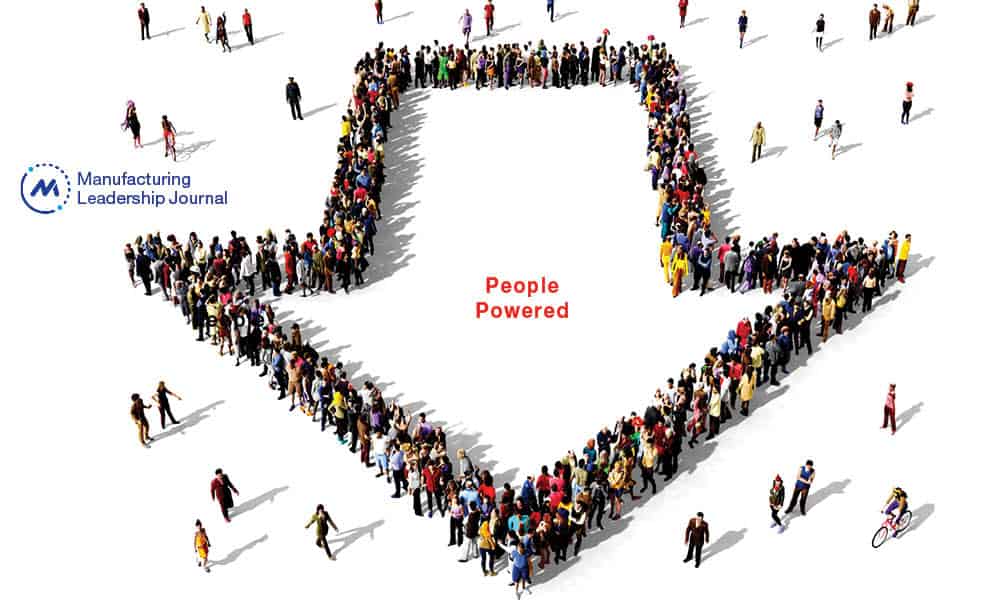
Why putting humans front and center in digital transformation is an essential component to success.

TAKEAWAYS:
● Organizational transformations are vital, yet they often fail because they are approached as a rational business journey and not as an emotional journey undertaken by employees.
● Research shows that manufacturers that focus on and invest in their people are 2.6 times more likely to succeed in their transformation efforts.
● There now is a framework of seven key interconnected and mutually reinforcing elements manufacturers can use to achieve and sustain a succesful transformation journey.
Manufacturers today face many challenges, from changing customer demands to rapidly evolving technology to persistent internal and external competitive disruptions. These are compounded by the exogenous risks of climate change, global health crises, geopolitical tensions, and political market interference.
Because of these ongoing challenges and risks, manufacturers need to transform successfully — and continuously. Their ability to thrive now depends on the agility with which they can quickly change to meet shifting customer, employee, investor, societal, environmental, technological, and regulatory factors.
Yet many manufacturers continue to struggle with such transformation. Why? Ernst & Young LLP (EY US) and the Saïd Business School University of Oxford teamed up on research1 to find out. We studied the complex factors behind the high failure rate of transformations and explored how leaders can drive transformations that result in lasting change.

“Organizational transformations fail because they approach transformation as a rational business journey and lack sufficient attention to the human conditions that drive success.”
We found that organizational transformations fail because they approach transformation as a rational business journey and lack sufficient attention to the human conditions that drive success. Conversely, those that succeed also focus on, and invest in, their people — and their people’s emotional journey — from the beginning. In fact, the research found that organizations that take this approach are 2.6 times more likely to have successful transformations than those that don’t.
Putting Humans at the Center
EY US calls this putting humans at the center of transformation, which involves addressing both the rational (processes, organizational design, and technology) and the emotional (leadership, culture, and capabilities) aspects of the journey in a balanced and integrated way.
Investment in the rational aspect provides discipline, structure, and platforms to manifest the shift quickly, while the emotional investment helps to keep everyone pushing forward, especially when things get messy. Historically, leaders have focused on the rational, logical parts of transformation. These, of course, are critical — they’re the foundation of how the business operates. Yet our research also shows the importance of the emotional journey — fostering positive instead of negative feelings among those involved — to the success or failure of a transformation. Keys to the emotional side include leaders who engage and rally their people around the change, a culture that encourages people to take ownership of the new ways of working, and capability-building to ensure that people are equipped to thrive in the new environment.
Building on these insights, we have converted what were identified as key drivers of successful transformation into a framework that can be used to stress test the likely efficacy of any given transformation program. (Figure 1) This framework consists of seven interconnected and mutually reinforcing elements — centered on a compelling vision, or an optimistic view of the future in which everyone can believe — that address the critical rational and emotional enablers of a successful and sustainable transformation journey.
Figure 1: A framework for putting humans at the center of transformation
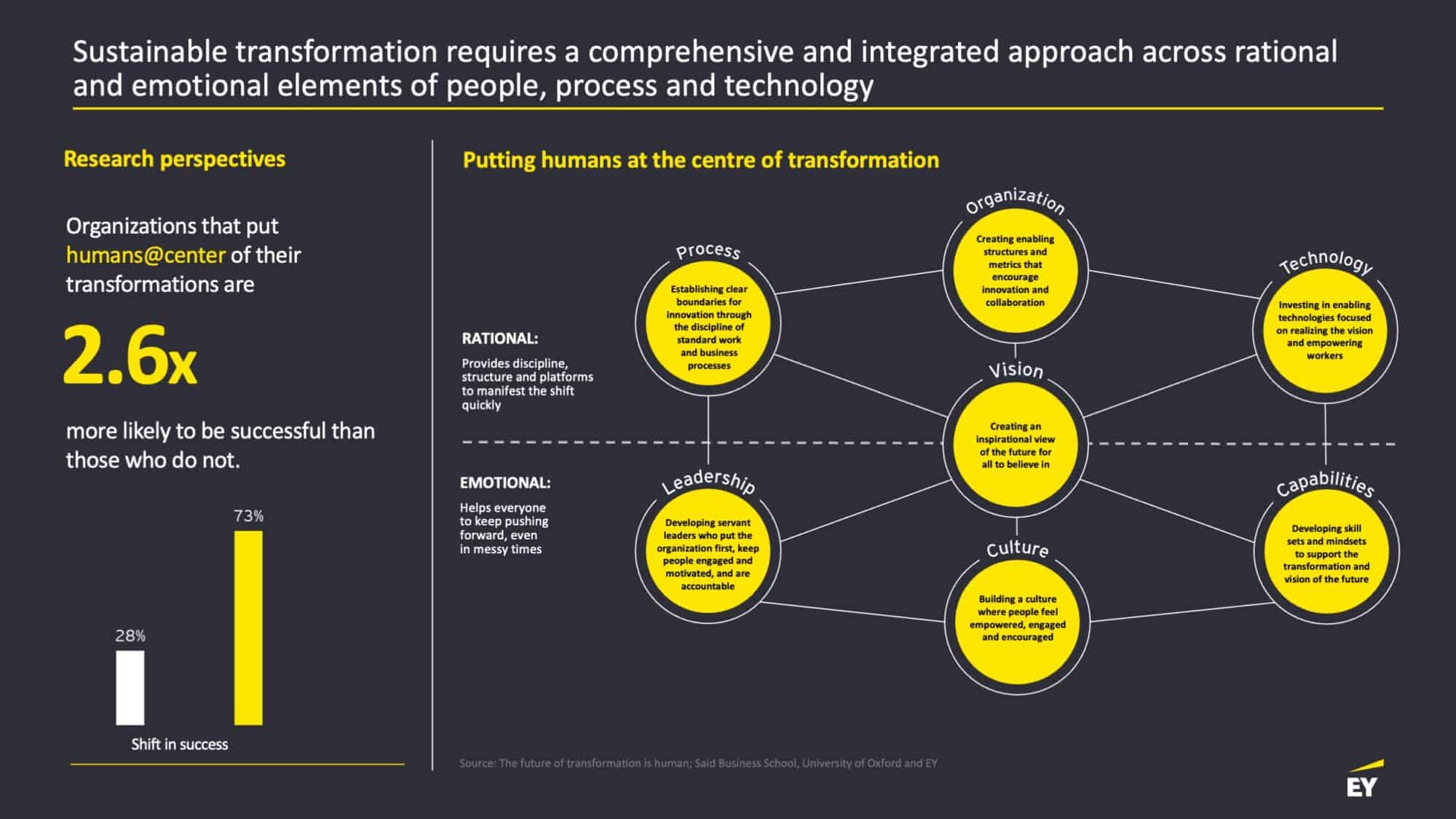
What’s Behind the Failure to Launch?
Based on our research and extensive experience in supporting transformation programs, we believe that companies need to adequately and concurrently address all seven areas of the framework to succeed. Unfortunately, this is where many manufacturers fall short. They may have comprehensive strategies and plans in a few areas, or even most of them. However, they are missing the mark on others, which is compromising their ability to get the most from their efforts.
For example, one automotive manufacturer had highly documented, well-written processes — there was no doubt what people needed to do to execute their jobs. But this wasn’t translating into the results that the company expected. A big reason was that the company lacked a compelling transformation vision that connected with employees. People knew what they were expected to do, but didn’t know why they were supposed to do it.
In another company struggling to make headway in its transformation, leaders, while acting with good intentions, were unknowingly thwarting change efforts. Essentially, they put accountability before capability. They expected workers to inherently understand new processes as well as they did. They weren’t giving workers the time and psychologically safe environment to explore and try out the new ways of working before holding them accountable for performance. They also underestimated the amount of capability-building needed for many of the workers to become proficient and effectively deliver on the shop floor.

“We believe that companies need to adequately and concurrently address all seven areas of the framework to succeed. Unfortunately, this is where many manufacturers fall short.”
A third company wasn’t getting results because it hadn’t identified the new incremental tasks that employees were expected to perform. The company had a massive three-ring binder that spelled out in minute detail its focus on building a future state culture. But leaders hadn’t taken the crucial next step to define what that means for people on the shop floor. Exactly what do workers need to now do differently on a daily basis? Workers weren’t disinterested in participating. They simply didn’t understand how to participate properly.
One of the most common obstacles that companies face is a mismatch between two of the rational elements: process and technology. This was the case at a global multinational manufacturer that was rolling out new software applications. The company felt that it had done all the right work up front to define the use cases and requirements and to pilot them at lighthouse sites, but still struggled with end-user adoption as it deployed the tools at scale. It turned out that the company hadn’t confirmed that the system was consistent with how the organization actually worked, and people weren’t interested in trying something new when they felt their current ways of doing things worked just fine.
A Practical Way to Get Started
As the above examples illustrate, inadequately addressing the human elements of transformation in conjunction with the more rational ones from the beginning most often results in, at best, tepid results and, at worst, outright failure.
How do other manufacturers avoid such outcomes? The obvious answer is that they begin by ensuring that there’s sufficient investment in, and attention to, each of the seven elements of the framework, as outlined in Figure 1. At the same time, it can take significant time and resources to initiate and align these seven elements. We’ve developed a very pragmatic approach that can be adopted at a manufacturing line, site, or network level to help lay a foundation for successful and sustainable transformation. Recognizing a company’s people (particularly those on the production line) will ultimately adopt and drive change, and our approach focuses in on changing day-to-day behaviors in a way that ultimately drives a positive shift in organizational culture.
Practically speaking, this starts with a laser focus on daily tasks. In our experience, the best way to spur behavior change is to first have people learn by doing. This means that leadership identifies a handful of key tasks for people to perform, trains them on the established standard (or current best practice) for each task, and sets them loose to implement the standard (while ensuring that people feel safe enough to make mistakes). The tasks are selected to address key performance improvement opportunities or personal pain points for operating teams, and they may involve leveraging new technology.
People quickly recognize that doing things the right way leads to better performance and a more pleasant job experience — the impact is clearly visible — which inspires confidence in the new way of working and eagerness to embrace it. Importantly, tasks should be explicitly tied to specific targets that teams must hit to help the company achieve its business goals. This helps people understand the direct link between their actions and the success of the business.

“Ultimately, when an organization gets a critical mass of behavior change — say, an entire team on the shop floor — it experiences the dawn of a new culture.”
Soon, with the right support, capability building and context, this new way of working becomes a habit, as people understand that doing things a certain way is just part of their daily job. Now it’s second nature, and the thought of doing things any other way isn’t an option. It’s like when people have progressed in a new exercise regimen and reach a stage where the possibility of not working out or running doesn’t even enter their minds. Here, leadership plays a key role in giving workers intellectual freedom with execution accountability, and in coaching to continue reinforcing the importance of maintaining discipline in how tasks are done so people want to continue doing things the right way even in the face of disruptions that could otherwise distract them.
Eventually, people reach the point at which they intellectually and emotionally know that it’s through the execution of those tasks that they have a better working day. And that’s when they begin to experience an actual behavior change. The timeline for reaching this stage varies by individual. Some people are highly engaged and get there quickly, while others take longer to see things play out. Here again, leadership must remain an active coach — ensuring focus, monitoring ongoing performance with periodic check-ins, demonstrating how people’s actions are addressing the relevant business targets, and encouraging people to actively look for new areas in which they can improve.
Ultimately, when an organization gets a critical mass of behavior change — say, an entire team on the shop floor — it experiences the dawn of a new culture. Everyone is doing their jobs according to the new performance-enhancing standards they’ve defined for their specific tasks (often with the help of new technology), and are updating those standards as necessary as they solve additional problems and learn ways to do things even better. Once established, this new culture and mindset can serve as a crucible of workers’ ideas for solving other problems beyond the shop floor — for instance, a sustainability challenge or any kind of inefficiency — because people now trust the process and the tools, and believe in them because they know that they work. This is when transformation really generates outsized and sustainable returns for the enterprise.
Put Humans at the Center
Today’s manufacturers stand at the precipice of an uncertain world. The nature and impact of disruption are accelerating, intensifying the need for manufacturers to transform. Leaders recognize the critical need for transformation, but many are unsure how to drive it successfully, or, in some cases, they are reluctant to deal with the potential risk involved. Many are still recovering from previous transformation efforts gone awry and are skeptical that a new one will turn out any better.
As our research has found, the key to transformation that delivers significant, sustained performance improvement is putting humans at the center of it all. This means addressing both the rational and emotional aspects of the transformation journey, underpinned by a compelling vision for the future in which people can believe.
A manufacturer’s power is truly in its people. And it’s time for all manufacturers to harness it to build a better business for today and tomorrow. M
About the authors:

Craig Lyjak is a Principal leading EY’s global Manufacturing Transformation solutions. As the leader of the EY/P&G alliance he leads a team focused on innovating methods and tools to create more effective, efficient, and sustainable transformations.

Paul Vail is a Partner in EY Canada’s Business Consulting Practice, Digital Supply Chain and Operations, as well as the Advanced Manufacturing and Mobility Consulting Leader for Canada.
1. As reported in “The Future of Transformation Is Human,” EY and University of Oxford Said Business School, 2022. The research involved a survey of 935 senior leaders and direct reports, as well as 1,127 workforce members from 23 countries and 16 industry sectors. Most respondents had led, or experienced, multiple transformations—both successful and underperforming.
